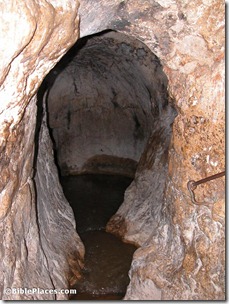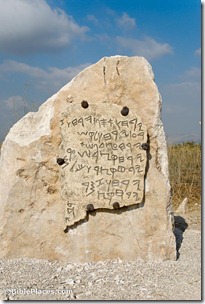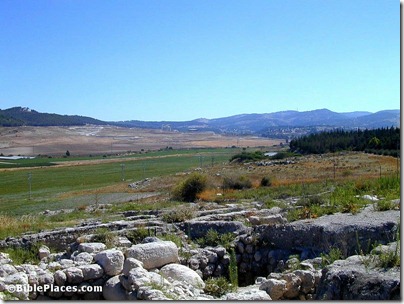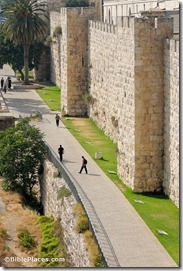Randall Price answers the question in a 15-minute video available at truelife.org. The video is clearly aimed at those who are less familiar with the subject and it covers discoveries from both the periods of the Old and New Testaments. Price is the author of the recently published Rose Guide to the Temple.
One of the most head-shaking stories of early explorers in Jerusalem is that of Montague Parker’s expedition to discover the Ark of the Covenant. Stephen Gabriel Rosenberg tells the story in the Jerusalem Post, and if you haven’t heard it before, it’s worth the read. Here’s an excerpt:
With the help of his two Turkish supervisors, Parker and his men claimed an area of ground near the entry to the Gihon water system, known at the time as the Virgin’s Spring, which was then fenced off and guarded by Turkish troops, who did not allow entry to any locals or other visitors. The Jerusalem Pasha Azmey Bey had been suitably bribed to turn a blind eye to the work.
Parker’s activity naturally aroused the intense concern of the local archeological community. The Germans, French and British all had their missions in Jerusalem, but Parker would give out no communication and allow no inspection. His men proceeded with the digging, but they were amateurs and it went slowly and with little result.
Back in London, the Finnish scholar Juvelius had hired an Irish medium, who studied the documents and sent directions to the team about suitable locations. He advised Parker to search the long water tunnel, so Parker sent to London to obtain the services of two mining engineers who had worked on the Metropolitan Railway, the first line of the London Underground. Then he made another excellent move.
The full account is here. If you like stories like this, I recommend Neil Asher Silberman’s Digging for God and Country. The book is out of print, but still available in used bookstores.
HT: Joseph Lauer
The Gihon Spring of Jerusalem
- Tagged Jerusalem
I’ve used Todd Bolen’s Pictorial Library of the Bible Lands collection for several months. I’ve tried it with Bible classes, history classes, sermons, etc. and my conclusion is…
Wow.
I posted on the new expanded set a few months ago before I had actually obtained it. It was clearly a useful product. Now that I’ve used it, I can’t imagine life without such a valuable, enriching tool.
The Pictorial Library set includes some 17,500 photos of nearly everything you could imagine in the Bible Lands. For me, the best part is the 400+ PowerPoint presentations included with the set. The PowerPoint files contain all of the photos ready-to-go. They are organized by location and contain great slide notes that inform and complete your presentation.
You can read all of Luke’s assessment at his blog.
You can learn more about the new Pictorial Library of Bible Lands here, download a free PowerPoint presentation of Caesarea here, and place an order here. Individual volumes cost $24-$39. The complete set of 18 volumes is now marked down to $389 (a 35% discount). Larger discounts are available for upgraders.
- Tagged Photo Resources
As you might have guessed, one afternoon is all the time they need to discuss the contributions of Robert Alexander Stewart Macalister. From the Agade list:
R.A.S. Macalister’s Contributions to the Archaeology of Palestine 100 Years Later: An Evaluation
Workshop to be held at the W.F. Albright Institute of Archaeology, 26 Salah ed-Din Street, Jerusalem on Thursday, December 13, 2012
1:15 Light refreshments
1:30 Welcome and Introduction, Sam Wolff, Israel Antiquities Authority and Albright Institute
Tel Gezer
1:40 Jonathan Tubb, Keeper, Middle East, The British Museum, R.A.S. Macalister: Villain or Visionary?
2:10 William H. Dever, Professor Emeritus, University of Arizona, A Response to Jonathan Tubb (to be read by S. Gitin)
2:25 Baruch Brandl, Israel Antiquities Authority, Are the Finds from Macalister’s Gezer I-III Still Relevant for Current Research a Century Later?
2:40 Tsvika Tsuk, National Parks Authority, Digging in Macalister’s Footsteps: The Gezer Water System
3:00 Eric Mitchell, Southwestern Baptist Theological Seminary, The Gezer Survey: An Assessment of Macalister’s Work (to be read by S. Wolff)
3:15 Discussion
3:30 Break
Jerusalem and Judean Shephelah Sites
3:45 Shimon Gibson, University of the Holy Land R.A.S. Macalister: with Bliss at Tell el-Judeideh
and with Duncan at Jerusalem
4:15 Oded Lipschits and Yuval Gadot, Tel Aviv University “Kabdehu veChasdehu” (“Respect Him but Suspect Him”): Digging Azekah after 113 Years
4:30 Amos Kloner, Professor Emeritus, Bar-Ilan University Subterranean Complexes at Mareshah and Additional Notes on the Judean Shephelah Hiding Complexes
4:45 Aren Maeir, Bar-Ilan University and Rona Avissar, Albright Institute, Bliss and Macalister’s Work at Tell es-Safi: A Reappraisal in Light of Recent Excavations
5:00 David Ussishkin, Professor Emeritus, Tel Aviv University and Ronny Reich, University of Haifa, concluding remarks, followed by discussion
The workshop is open to all interested scholars. Please RSVP your intention to attend to Sam Wolff (sam at israntique.org.il).
A replica of the Gezer Calendar, found in the Macalister’s excavation dump
- Tagged Lectures
A press release from the American Friends of Tel Aviv University announces the recent discovery of a holy place that was not always a holy place.
Tel Aviv University researchers have uncovered a unique 11th-century BCE sacred compound at the site of Tel Beth-Shemesh, an ancient village that resisted the aggressive expansion of neighboring Philistines. The newly discovered sacred complex is comprised of an elevated, massive circular stone structure and an intricately constructed building characterized by a row of three flat, large round stones. Co-directors of the dig Prof. Shlomo Bunimovitz and Dr. Zvi Lederman of TAU’s Sonia and Marco Nadler Institute of Archaeology say that this temple complex is unparalleled, possibly connected to an early Israelite cult — and provides remarkable new evidence of the deliberate desecration of a sacred site.
[…]
After ruling out the use of the site as a domestic structure, the researchers knew that they had found something unique. Excavations revealed almost only shards of painted chalices and goblets found spread on the floor but no traces of domestic use. One of the three flat stones was surrounded by animal bone remnants, and the two other stones were seemingly designed to direct liquids. These clues convinced Prof. Bunimovitz and Dr. Lederman that they had uncovered a likely place of sacred worship.
But the temple didn’t remain sacred. Samples of earth taken from layers above the destroyed temple and analyzed at the Weizmann Institute of Science revealed astonishing results. Directly above the temple was a packed-in layer containing phytoliths (remains of weeds that are commonly eaten by livestock) and spherulites (microscopic remnants of manure produced by grass-eating animals), indicating the presence of animal pens directly on top of the sacred site, explains Prof. Bunimovitz. Intermittent burning in order to clean the pens likely resulted in the concentrated state of the layer.
This desecration was no accident or coincidence, the researchers believe. Instead, it represents the see-saw of political might between the Philistines and the local population. Presumably the Philistines gained temporary control of Beth-Shemesh, and brought in livestock to live on what they knew had been a sacred site to their enemies.
The article does not mention Samson, but this is roughly the period when he lived in the town across the valley.
HT: David Coppedge
View from the excavations of Beth Shemesh towards Samson’s place of birth and burial
- Tagged Discoveries, Excavations, Shephelah
The title of this article at the Jerusalem Post will get your attention, but it’s a bit misleading. If you think of it primarily as ways to leave Jerusalem, it’s more accurate. The top 5 are:
- Segway
- ATV
- Bike Tours
- Jeep Tours
- Horse-riding
The article gives more details and includes phone numbers. If you want to see Jerusalem, you really need to walk.
HT: Charles Savelle
Search
About the BiblePlaces Blog
The BiblePlaces Blog provides updates and analysis of the latest in biblical archaeology, history, and geography. Unless otherwise noted, the posts are written by Todd Bolen, PhD, Professor of Biblical Studies at The Master’s University.
Subscribe
Tags
10th Century
American Colony Photos
Analysis
Antiquities Trade
Dead Sea
Dead Sea Scrolls
Discoveries
Egypt
Excavations
Forgery
Galilee
Greece
Holidays
Israel's Coast
Italy
Jerusalem
Jezreel Valley
Jordan
Jordan Rift
Judah
Lebanon
Lectures
Mediterranean Islands
Mesopotamia
Museums
Negev
New Exhibits
Persia
Philistines
Photo Resources
Picture of the Week
Pseudo-Archaeology
Resources
Sad News
Samaria
Shephelah
Syria
Technology
Temple Mount
Tomb of Jesus
Tourism
Travels
Turkey
Weather
Weekend Roundup
Links
Notice
As an Amazon Associate we earn from qualifying purchases. In any case, we will provide honest advice.




